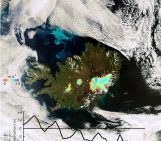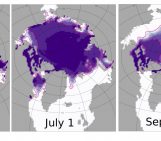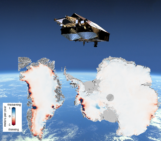
Let’s continue the journey of discovering cool facts about sea ice which started with breaking the ice. This time, we’re diving into a fascinating part of the Arctic and Antarctic: the Marginal Ice Zone (MIZ). Imagine a place where the vast, frozen world of sea ice meets the moving waters of the ocean underneath. This is the MIZ, a unique area where air, water, and ice mix and mingle. It’s not just a cold, icy world; it’s also home to a variety of animals and plants that have adapted to life in this ever-changing environment. But with the climate changing, this special area and its inhabitants are facing new challenges.
The Puzzle of the Marginal Ice Zone (MIZ)
The MIZ, found in various parts of the world’s polar regions, including the Barents and Kara Sea, is like a giant puzzle. Ocean currents, ice movements, growth and melting, and weather patterns all come together here (Fig. 2), making it a tricky place to study. Despite these challenges, scientists are working hard to learn more about it (Fig. 3). They brave the cold and the danger to gather information about this important area.
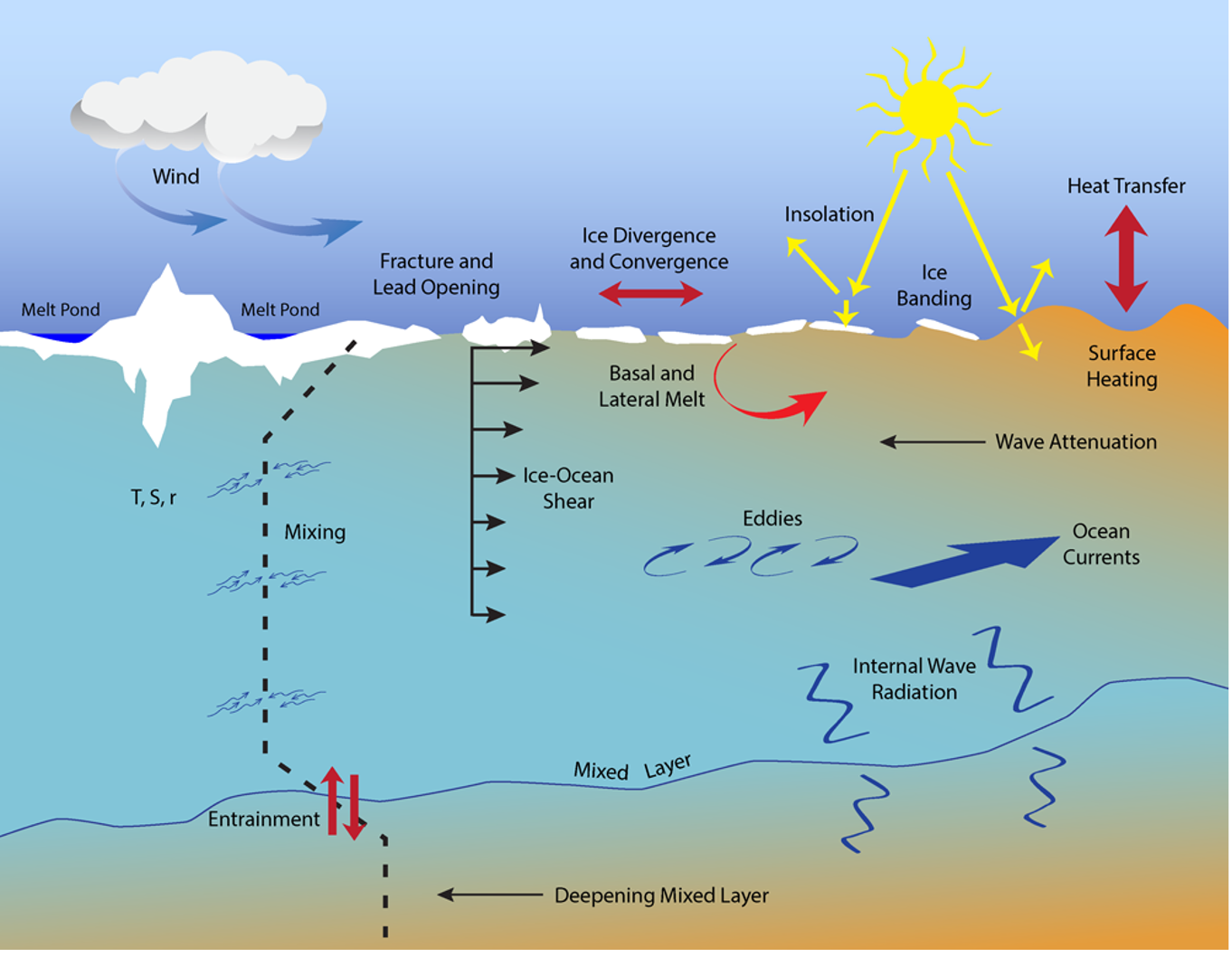
Figure 2: Scheme of the momentum and energy exchanges between air, ocean, and sea ice. [Credit: APL – https://www.apl.washington.edu/project/project.php?id=miz]
A Closer Look at the MIZ in the Barents Sea
One big question is: how can we keep an eye on the MIZ as it changes over the years? To answer this question, in our recent discussion paper, we move our focus on the Atlantic side of the Arctic and zoom in on a specific example: the Barents Sea in the Arctic. This is a place where both storms and ocean currents play a big role in shaping the ice and it is an important region for human activities, (shipping, fishing, tourism, and navigation) due to the susceptible changes with the ongoing Atlantification (the growing influence of the Atlantic Ocean on the Arctic, as described by Polyakov et al., 2017). On February 17, 2015, we used satellites to take a picture of the MIZ in the Barents Sea (Figure 1). The different payloads show how the waves from the ocean were shaping the ice. This helps us detect how the waves affect the ice covered region and define where the MIZ starts and ends, which traditional parameter definition (sea ice concentration) lack the detail necessary to provide this level of insight.
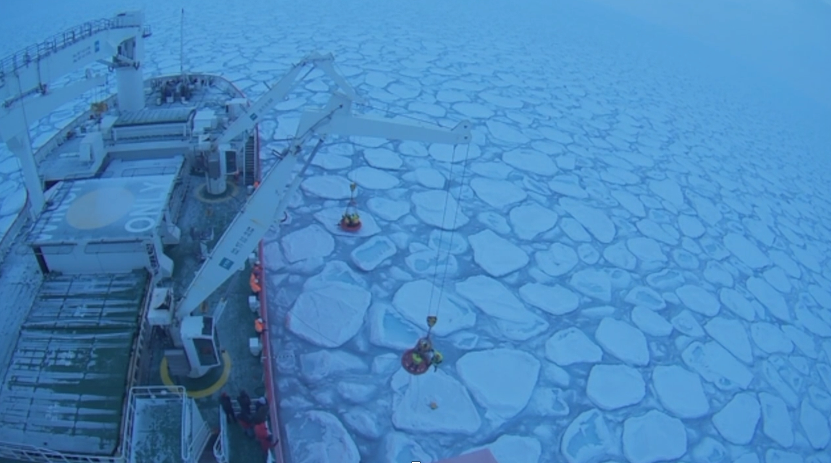
Figure 3: Scientists measuring and observing in the Southern Ocean with the SA Agulhas II research vessel during a storm on 4th July 2017. [Credit: Vichi et al., 2019]
Tracking Changes Over Time
In our recent study, to refine the ice area that is affected by ocean/waves, we used a number of different satellites, (i) radar-equipped CryoSat-2 and the laser-based ICESat-2, which are excellent for measuring the height and thickness of the sea ice; (ii) high-resolution Sentinel-1, which employs radar to scan and image the Earth’s surface. A great example of this is shown in Figure 1, where CryoSat-2 helped us to detect ocean signals beneath the sea ice, which was greatly confirmed by observations from Sentinel-1.
As such, we have created a Climate Data Record (CDR) for the wave-affected MIZ in the Atlantic Arctic, spanning a period of 12 years from 2010 to 2022, following in the footsteps of and expanding upon early studies from the 1980s (Rapley, 1984). It includes the coverage of MIZ for each month. It serves as a detailed record, capturing the nuanced interactions between air, ice, and ocean, and is particularly valuable in the context of the rapid changes currently observed in the Arctic’s ice and climate.
Expanding Our Horizons & Looking Forward
We are not stopping at the Arctic; we are also looking at the Antarctic to see how the ice is changing there, especially with the recent abrupt losses of Antarctic sea ice. We are not only looking at the present: our mission is to delve into the past as well, traveling back to the 1970s. As a next step, we plan to enrich our MIZ CDR with data from earlier satellites like SeaSAT. This journey through time will help us better understand the history and evolution of these dynamic icy borders.
As we look forward, we are on the threshold of a new era in satellite exploration. Upcoming missions by space agencies like ESA and NASA are set to offer more comprehensive and detailed observations. These missions, while enhancing our understanding of the MIZ in polar regions, go beyond this scope. They encompass a wide range of environmental and climatic studies, promise to bring unprecedented detail and scope to our Earth System observations. By combining these diverse observations we will gain a more complete understanding of how our planet’s climate is changing.
Further reading
- Read the original open discussion paper by Weixin and Lu: Zhu et al.: A 12-Year Climate Record of Wintertime Wave-Affected Marginal Ice Zones in the Atlantic Arctic based on CryoSat-2, Earth Syst. Sci. Data Discuss.
- Rapley (1984): First observations of the interaction of ocean swell with sea ice using satellite radar altimeter data, Nature 307.
- Vichi et al., (2019): Effects of an Explosive Polar Cyclone Crossing the Antarctic Marginal Ice Zone, Geophysical Research Letters 46.
- Polyakov et al., (2017): Greater role for Atlantic inflows on sea-ice loss in the Eurasian Basin of the Arctic Ocean, Science 356.
- A previous blog post about Marginal Ice Zone: Does size really matter? A story of ice floes and power laws
- Another blog post and a different view on the sea ice edge: Life on the (Ice) Edge: Antarctic Seabirds and Sea Ice
- More research about the marginal ice zone
Edited by Maria Scheel and Lina Madaj
 Weixin Zhu is a PhD Student at the Tsinghua University, China. She works on the retrieval of marginal ice zones with radar altimeters. The long-term and continuous records of radar altimeters offer new potential to study the critical interactions between sea ice, the ocean, and the atmosphere within marginal ice zones, as well as to understand the response of the marginal ice zone to climate change. Contact Email: zwx19@mails.tsinghua.edu.cn
Weixin Zhu is a PhD Student at the Tsinghua University, China. She works on the retrieval of marginal ice zones with radar altimeters. The long-term and continuous records of radar altimeters offer new potential to study the critical interactions between sea ice, the ocean, and the atmosphere within marginal ice zones, as well as to understand the response of the marginal ice zone to climate change. Contact Email: zwx19@mails.tsinghua.edu.cn
 Lu Zhou is an Assistant Professor at Utrecht University, Netherland. Her research focuses on remote sensing of Arctic and Antarctic sea ice and snow using altimeter and radiometer. She also strives to uncover the interaction between atmosphere-ice-ocean system from observations. She is one of the editors of this blog and tweets as @LuZhou_Isabella. Contact email: l.zhou@uu.nl
Lu Zhou is an Assistant Professor at Utrecht University, Netherland. Her research focuses on remote sensing of Arctic and Antarctic sea ice and snow using altimeter and radiometer. She also strives to uncover the interaction between atmosphere-ice-ocean system from observations. She is one of the editors of this blog and tweets as @LuZhou_Isabella. Contact email: l.zhou@uu.nl

